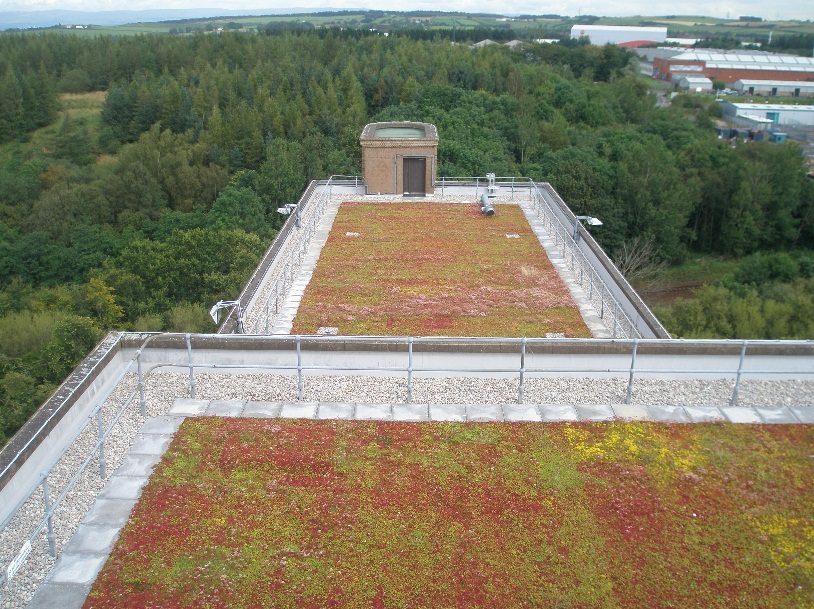
The environmental benefits of green roofs have been well-documented and are supported by many years of research and measurement. The cost benefits, however, are often not as well reported and these should be highlighted to generate greater interest in the technology.
Green roofs have a positive effect in terms of thermal insulation by cooling buildings during the warmer summer months and provide additional insulation for heat during the winter. Evidence from the UK, mainland Europe and North America has indicated that savings in energy made from green roof installations has provided payback times in the region of three-to-five years. A green roof in Canary Wharf, London is estimated to save £5,000 per year, while German studies has shown 2 litres/year of fuel is saved for every square metre of green roof.
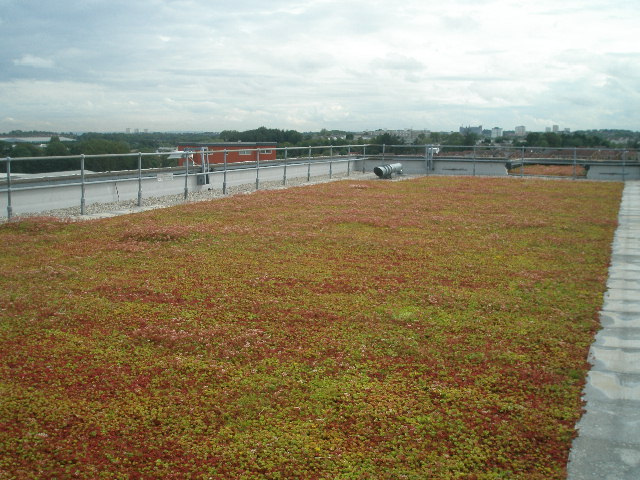
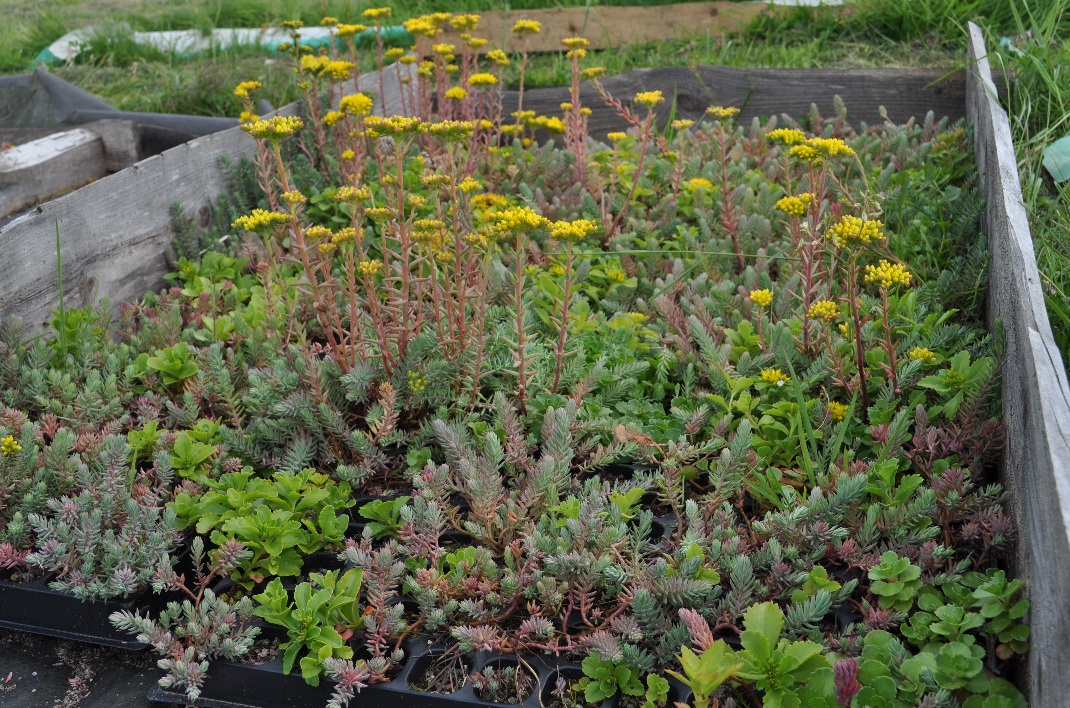
Sedum Roof (© Bauder) Sedum plug plants ready for transplantation (© Highland Green Roofs)
Other studies (http://www.livingroofs.org/images/stories/pdfs/hacnovlivroofp16-181.pdf) have also shown that green roofs assist greatly in creating a more constant internal temperature than conventional roof systems. This is particularly attractive for example in plant and server rooms. If the maintenance costs of heating and cooling plant are added to these savings, the installation of green roofs as a method of regulating internal temperature has clear benefits over conventional systems.
Further cost savings, in comparison to conventional roofs, can be provided by green roofs when the drainage costs are considered. Savings are not always obvious as cost estimation procedures do not always identify the link between the green roof and the building’s drainage provision. For example, a green roof installation will provide surface water run-off attenuation at a building plot scale and downstream thereafter, consequently, reducing the frequency and size of related drainage infrastructure.
|
Standard non green roof |
Green roof 50mm of substrate |
Green roof 100mm substrate |
Green roof 150mm substrate |
|
81% annual runoff |
50% annual runoff |
45% annual runoff |
40% annual runoff |
Belgian study results showing reduction in runoff compare green roof to conventional roof.
Green roofs also have the potential to extend the life expectancy of roof systems (typically greater than twice that of conventional roofing systems) by protecting the waterproofing membrane from climatic extremes, UV light & mechanical damage. This will create a saving on maintenance costs compared to conventional roofs.
Water Retention
Effective rainwater management, in particular urban water management, is a key challenge for Scotland. Many urban drainage systems are under severe pressure, especially during intense rainfall events, and the costs of maintaining and upgrading rainwater drainage systems are a burden. Green roofs have the ability to ameliorate the impact of rainwater run-off, which helps to reduce flood risk.
With accelerating urban growth, naturally draining soils are covered with sealed surfaces such as buildings, roads, car parks and pavements, decreasing percolation
into the ground and increasing run-off. The ability of flood plains to mitigate flooding is reduced as they are developed and urban watercourses are locked away in drains and culverts reducing their ability to deal with flood waters. Research has shown that green roofs can contribute to flood mitigation, capturing between 40% and 90% of annual roof water run-off. It is best practice to encourage management of run-off as close as possible to where it lands and roofs are a first point of contact.
Sustainable Drainage Systems (SUDS) aim to address urban drainage problems by mimicking natural drainage patterns. Green roofs are currently an underused element in SUDS schemes but make can an excellent addition, dealing with rainfall at source, reducing run-off and removing pollutants.
Urban Heat Island Effect
In cities, summer heat can be excessive and unpleasant. Increased temperature creates a greater demand for energy to run air conditioning and is also considered a health risk. While this might not be considered a frequent problem currently in Scottish cities, there is increasing concern over predicted temperature rises in the future as a result of climate change.
The temperature in cities has been shown to be as much as 6° C higher than surrounding countryside. The natural cooling effect of evaporation of water from plants and soil lowers the temperature of surrounding air. Hard surfaces tend to absorb incoming solar radiation during the day, then release or reflect heat at night, raising air temperatures. Covering roof space with green surfaces will reduce the heat island effect.
Habitat Provision
Habitat loss is one of the most significant causes of biodiversity reduction. Habitats created on green roofs can mitigate the loss of some habitat types. Green roofs are particularly valuable in urban environments, increasing the extent and diversity of green space and utilising features which are traditionally of low habitat value – roofs. There is significant potential for green roofs to become an important component in the network of green spaces in urban environments. The bigger these green networks are, the greater the benefi ts for people and nature. The benefits of green roofs in respect of mitigating local temperature and reducing pollution in air and water can also contribute to the protection of urban biodiversity.
Green roofs can alsocontribute to a green network by providing additional habitat and species diversity in an urban area, and acting as stepping stones or corridors to allow species movement around often inpermeable areas. This can contribute to a network of habitats in urban areas that will provide a refuge for wildlife from adjacent sites.
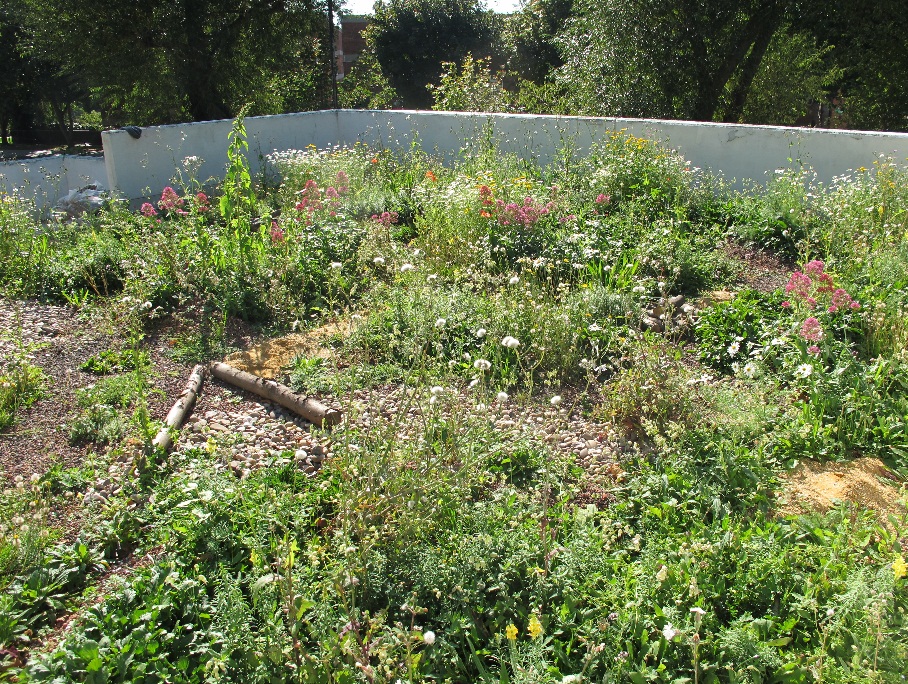
Biodiverse roof at Abbey Hive (© Buglife)
Air Pollution
Urban air quality is a significant health concern. The UK Government’s Environmental Audit Committee suggested in 2010 that up to 50,000 people a year in the UK may be dying prematurely due to air pollution. Various studies have been undertaken to quantify the extent to which trees and shrubs are able to reduce levels of air pollution, and this also applies to green roofs. The plants on a green roof can trap and fi lter pollutants which threaten human health.
Health and Well Being
Creating green roofs can contribute to better places to live and work by providing improved visual appearance of the built environment from offices and homes as well as access to green space for office staff. There is a lack of accessible open space in built up areas that is available to everyone. The provision of roof gardens and well designed green roofs with access for office staff can go some way to contributing to quality open space.
In dense urban environments there is often a lack of green space for residents. Roof Gardens and roof top parks provide important green spaces to improve the quality of life for urban residents.
Natural England has published research that suggests that an accessible natural green space should be no more than 300 metres from where anyone lives in order to meet people's needs for contact with nature. Studies suggest that regular direct contact with natural green space (and elements of the natural world such as birdsong and seasonal colour change) is good for people's health.
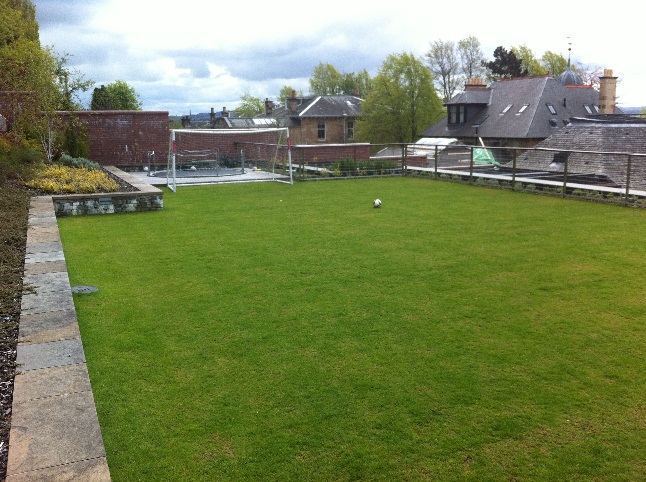
Football pitch at Pollockshields House (© Bauder)
Whole Life Costs
The cost of installing a green roof can vary in relation to the depth of the growing medium and the species of plants used, generally, a green roof will cost more to install than most other flat roof systems. However, there are economic benefits, as the whole life cost of the roof can be lower. In particular, the life expectancy of the waterproofing layer is increased substantially due to the protection of the membrane from ultraviolet light and other environmental exposures. It is claimed that in some cases this could be as much as 100%.
Around the world, city water rates are reduced pro rata in relation to the area of green roof covered, reflecting the reduced load on the sewer systems. A similar policy could have significant impact for many cities in Scotland.
Energy Efficiency
Thermal insulation is a key consideration in building design, keeping them cool in the summer and warm in the winter. Effective insulation will result in significant cost savings by reducing heating and cooling requirements. Green roofs have been proven to consistently lower the heat transfer between the building and external environment. The plants and growing medium absorb sunlight and reflect heat as part of their natural processes.
Green roofs have been shown to reduce the daily energy demand for air conditioning in the summer by over 75% through the process of evapotranspiration. In the winter, they remove direct contact of the membrane with winter winds, increasing overall thermal performance of the building. While green roofs do not perform like standard insulation, energy savings have been shown to amount to 2.5kWh/m2/yr. Green roofs can also contribute to Building Standards efficiency requirements.
Recent research by the European Commission and published in Applied Energy, suggests that green roofs reduce energy demand throughout the whol year in all parts of Europe, but that the cost savings are more in the cooler climates of northern Europe where there is a lower need for watering or irrigating green roofs during the summer. In some circumstances in southern Europe, the costs associated with watering the roofs outweighed the reduced energy demand. The full article and links to the journal paper can be found here.